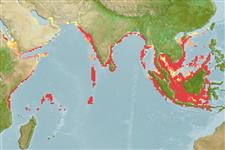Common names from other countries
Environment: milieu / climate zone / depth range / distribution range
Sinh thái học
Biển Sống nổi và đáy; Mức độ sâu ? - 60 m (Ref. 114953). Tropical; 28°N - 10°S, 33°E - 120°E (Ref. 114953)
Indo-West Pacific: Red Sea, India (including Sri Lanka) to Indonesia, north to Japan (Ref. 114953). Australian and old records from the Mediterranean Sea and Suriname need confirmation.
Bộ gần gũi / Khối lượng (Trọng lượng) / Age
Maturity: Lm ? range ? - ? cm
Max length : 300 cm TL con đực/không giới tính; (Ref. 58048)
Found inshore (Ref. 9909) and offshore (Ref. 58784). A carnivorous fish that feeds on large shellfishes (Ref. 58784). Ovoviviparous (Ref. 50449). Biology little known (Ref. 9909). Caught occasionally by demersal tangle net fisheries operating throughout the area. Utilized for its meat, find (both very high value), skin and cartilage (Ref.58048). Marketed fresh and probably dried-salted (Ref. 9909).
Life cycle and mating behavior
Maturities | Sự tái sinh sản | Spawnings | Egg(s) | Fecundities | Ấu trùng
Exhibit ovoviparity (aplacental viviparity), with embryos feeding initially on yolk, then receiving additional nourishment from the mother by indirect absorption of uterine fluid enriched with mucus, fat or protein through specialised structures (Ref. 50449).
Compagno, L.J.V., 1999. Checklist of living elasmobranchs. p. 471-498. In W.C. Hamlett (ed.) Sharks, skates, and rays: the biology of elasmobranch fishes. Johns Hopkins University Press, Maryland. (Ref. 35766)
IUCN Red List Status (Ref. 130435)
Threat to humans
Harmless
Human uses
Các nghề cá: Tính thương mại
Các công cụ
Special reports
Download XML
Các nguồn internet
Estimates based on models
Preferred temperature (Ref.
115969): 24.8 - 29.1, mean 28.1 (based on 1958 cells).
Phylogenetic diversity index (Ref.
82804): PD
50 = 0.5156 [Uniqueness, from 0.5 = low to 2.0 = high].
Bayesian length-weight: a=0.00372 (0.00145 - 0.00950), b=3.09 (2.87 - 3.31), in cm Total Length, based on LWR estimates for this (Sub)family-body shape (Ref.
93245).
Mức dinh dưỡng (Ref.
69278): 3.5 ±0.37 se; based on food items.
Thích nghi nhanh (Ref.
120179): thấp, thời gian nhân đôi của chủng quần tối thiểu là 4.5 - 14 năm (Fec assumed to be <100).
Fishing Vulnerability (Ref.
59153): Very high vulnerability (90 of 100).
